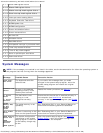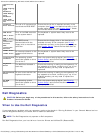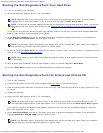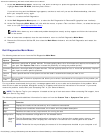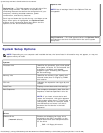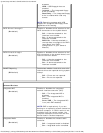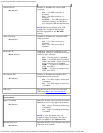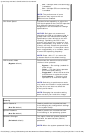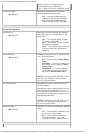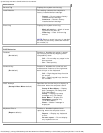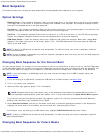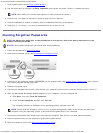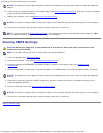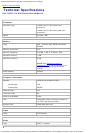
System Setup: Dell XPS 710 H2C Edition Service Manual
file:///C|/Preeji_working%20folder/Projects/E-Doc/Dimension%20and%20XPS/xps-710-h2c/SM/syssetup.htm[3/13/2013 11:45:28 AM]
USB Controller
(On default)
Enables or disables the internal USB
controller.
Off — The USB controller is
disabled.
On — The USB controller is
enabled.
No Boot — The USB controller is
enabled; however, the BIOS will
not recognize USB storage devices.
NOTE: Operating systems with USB
support will recognize USB storage
devices regardless of the No Boot
setting.
1394 Controller
(On default)
Enables or disables the integrated IEEE
1394 controller.
Off — The 1394 controller is
disabled.
On — The 1394 controller is
enabled.
Serial Port #1
(Auto default)
Disables or selects the address for the
integrated serial port and determines how
the serial port operates.
Off — The serial port is disabled.
Auto — The BIOS selects between
COM1 and COM3; if both resources
are in use the port is disabled.
COM1 — The port is configured at
3F8h with IRQ 4.
COM3 — The port is configured at
3E8h with IRQ 4.
PS/2 Mouse Port
(On default)
Enables or disables the onboard PS/2-
compatible mouse controller.
Off — The PS/2 legacy mouse port
is disabled.
On — The PS/2 legacy mouse port
is enabled.
LED color Adjusts the color of the front and back
LEDs (see About Your XPS Computer
).
Performance
Hyper-Threading
(On default)
Specifies whether each physical processor
appears as one or two logical processors.
Off — Hyper-Threading technology
is disabled.
On — Hyper-Threading technology
is enabled.
NOTE: If your processor does not
supports Hyper-Threading, this option
does not appear in the Options List.
Multiple CPU Core
(On default)
Specifies whether the processor has more
than one core enabled.



